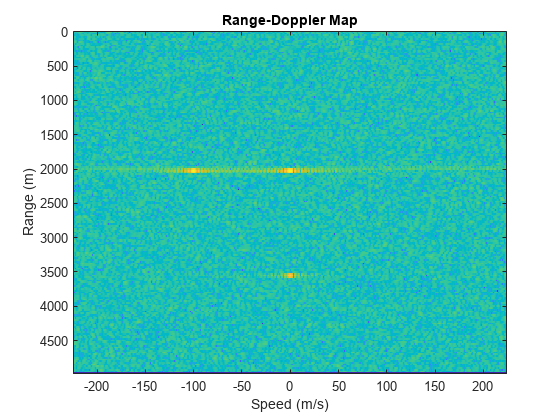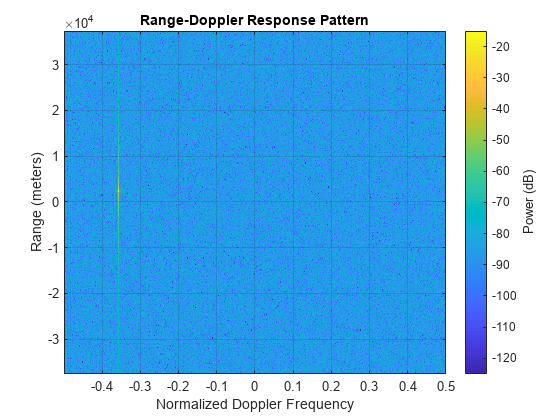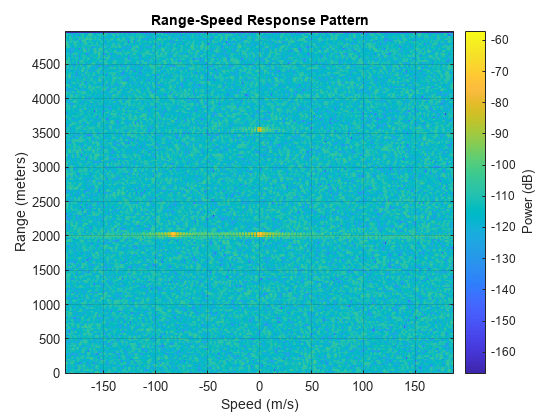phased.RangeDopplerResponse
Range-Doppler response
Description
The phased.RangeDopplerResponse
System object™ calculates the filtered response to fast-time and slow-time data. or
equivalently, range data, using either a matched filter or an FFT.
The input to the range-Doppler response object is a data cube. The organization of the data cube follows the Phased Array System Toolbox™ convention. The first dimension of the cube represents the fast-time samples or ranges of the received signals. The second dimension represents multiple channels such as sensors or beams. The third dimension, slow time, represent pulses. If the data contains only one channel or pulse, the data cube can contain fewer than three dimensions. Range processing operates along the first dimension of the cube. Doppler processing operates along the last dimension.
The output of the object is also a data cube with the same number of dimensions as the input. The first dimension contains range-processed data but its length can differ from the first dimension of the input. The last dimension contains Doppler processed data. Its length can differ from the last dimension of the input.
To compute the range-Doppler response:
Define and set up your
phased.RangeDopplerResponseSystem object. See Creation.Call the object to compute the range-Doppler response of the input signal according to the properties of
phased.RangeDopplerResponse.
Creation
Description
response = phased.RangeDopplerResponseresponse. The object calculates the
range-Doppler response of the input data.
response = phased.RangeDopplerResponse(Name=Value)response
System object with each specified property Name set to the
specified Value. You can specify additional name-value pair
arguments in any order as
(Name1=Value1,...,NameN=ValueN).
Properties
Usage
Syntax
Description
[ calculates the range-Doppler response
of the input signal, resp,rnggrid,dopgrid]
= response(x)x. resp is the
complex range-Doppler response. rnggrid and
dopgrid provide the range samples and Doppler samples,
respectively, at which the range-Doppler response is evaluated. This syntax is
available when you set the RangeMethod
property to 'FFT' and the DechirpInput property to false. This syntax is
most commonly used with FMCW signals.
[ uses
resp,rnggrid,dopgrid]
= response(x,xref)xref as the reference signal to dechirp
x. This syntax is available when you set the RangeMethod property to 'FFT'
and the DechirpInput property to
true. This syntax is most commonly used with FMCW
signals, where the reference signal is typically the transmitted signal.
[ uses
resp,rnggrid,dopgrid]
= response(x,coeff)coeff as the matched filter coefficients. This syntax
is available when you set the RangeMethod
property to 'Matched filter'. This syntax is most commonly
used with pulsed signals, where the matched filter is the time reverse of the
transmitted signal.
Input Arguments
Output Arguments
Object Functions
To use an object function, specify the
System object as the first input argument. For
example, to release system resources of a System object named obj, use
this syntax:
release(obj)
Examples
Algorithms
Extended Capabilities
Version History
Introduced in R2012b
See Also
Functions
Objects
phased.RangeAngleResponse|phased.RangeResponse|phased.AngleDopplerResponse|phased.MatchedFilter|phased.DopplerEstimator|phased.RangeEstimator|phased.CFARDetector|phased.CFARDetector2D


